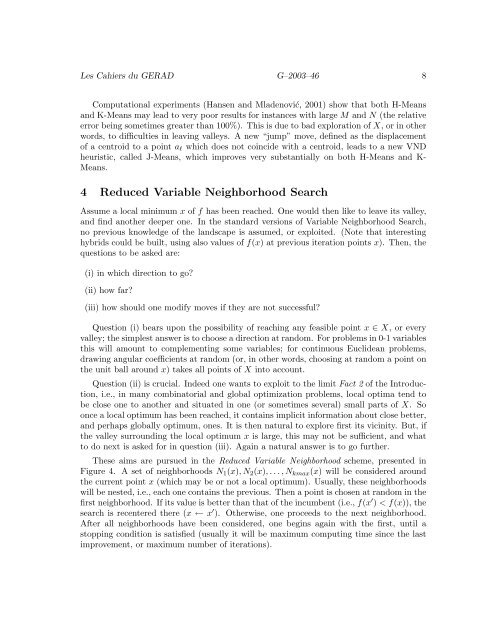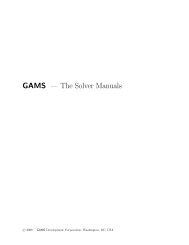A Tutorial on Variable Neighborhood Search
A Tutorial on Variable Neighborhood Search
A Tutorial on Variable Neighborhood Search
Create successful ePaper yourself
Turn your PDF publications into a flip-book with our unique Google optimized e-Paper software.
Les Cahiers du GERAD G–2003–46 8<br />
Computati<strong>on</strong>al experiments (Hansen and Mladenović, 2001) show that both H-Means<br />
and K-Means may lead to very poor results for instances with large M and N (the relative<br />
error being sometimes greater than 100%). This is due to bad explorati<strong>on</strong> of X, or in other<br />
words, to difficulties in leaving valleys. A new “jump” move, defined as the displacement<br />
of a centroid to a point a l which does not coincide with a centroid, leads to a new VND<br />
heuristic, called J-Means, which improves very substantially <strong>on</strong> both H-Means and K-<br />
Means.<br />
4 Reduced <strong>Variable</strong> <strong>Neighborhood</strong> <strong>Search</strong><br />
Assume a local minimum x of f has been reached. One would then like to leave its valley,<br />
and find another deeper <strong>on</strong>e. In the standard versi<strong>on</strong>s of <strong>Variable</strong> <strong>Neighborhood</strong> <strong>Search</strong>,<br />
no previous knowledge of the landscape is assumed, or exploited. (Note that interesting<br />
hybrids could be built, using also values of f(x) at previous iterati<strong>on</strong> points x). Then, the<br />
questi<strong>on</strong>s to be asked are:<br />
(i) in which directi<strong>on</strong> to go<br />
(ii) how far<br />
(iii) how should <strong>on</strong>e modify moves if they are not successful<br />
Questi<strong>on</strong> (i) bears up<strong>on</strong> the possibility of reaching any feasible point x ∈ X, or every<br />
valley; the simplest answer is to choose a directi<strong>on</strong> at random. For problems in 0-1 variables<br />
this will amount to complementing some variables; for c<strong>on</strong>tinuous Euclidean problems,<br />
drawing angular coefficients at random (or, in other words, choosing at random a point <strong>on</strong><br />
the unit ball around x) takes all points of X into account.<br />
Questi<strong>on</strong> (ii) is crucial. Indeed <strong>on</strong>e wants to exploit to the limit Fact 2 of the Introducti<strong>on</strong>,<br />
i.e., in many combinatorial and global optimizati<strong>on</strong> problems, local optima tend to<br />
be close <strong>on</strong>e to another and situated in <strong>on</strong>e (or sometimes several) small parts of X. So<br />
<strong>on</strong>ce a local optimum has been reached, it c<strong>on</strong>tains implicit informati<strong>on</strong> about close better,<br />
and perhaps globally optimum, <strong>on</strong>es. It is then natural to explore first its vicinity. But, if<br />
the valley surrounding the local optimum x is large, this may not be sufficient, and what<br />
to do next is asked for in questi<strong>on</strong> (iii). Again a natural answer is to go further.<br />
These aims are pursued in the Reduced <strong>Variable</strong> <strong>Neighborhood</strong> scheme, presented in<br />
Figure 4. A set of neighborhoods N 1 (x),N 2 (x),...,N kmax (x) will be c<strong>on</strong>sidered around<br />
the current point x (which may be or not a local optimum). Usually, these neighborhoods<br />
will be nested, i.e., each <strong>on</strong>e c<strong>on</strong>tains the previous. Then a point is chosen at random in the<br />
first neighborhood. If its value is better than that of the incumbent (i.e., f(x ′ )
















